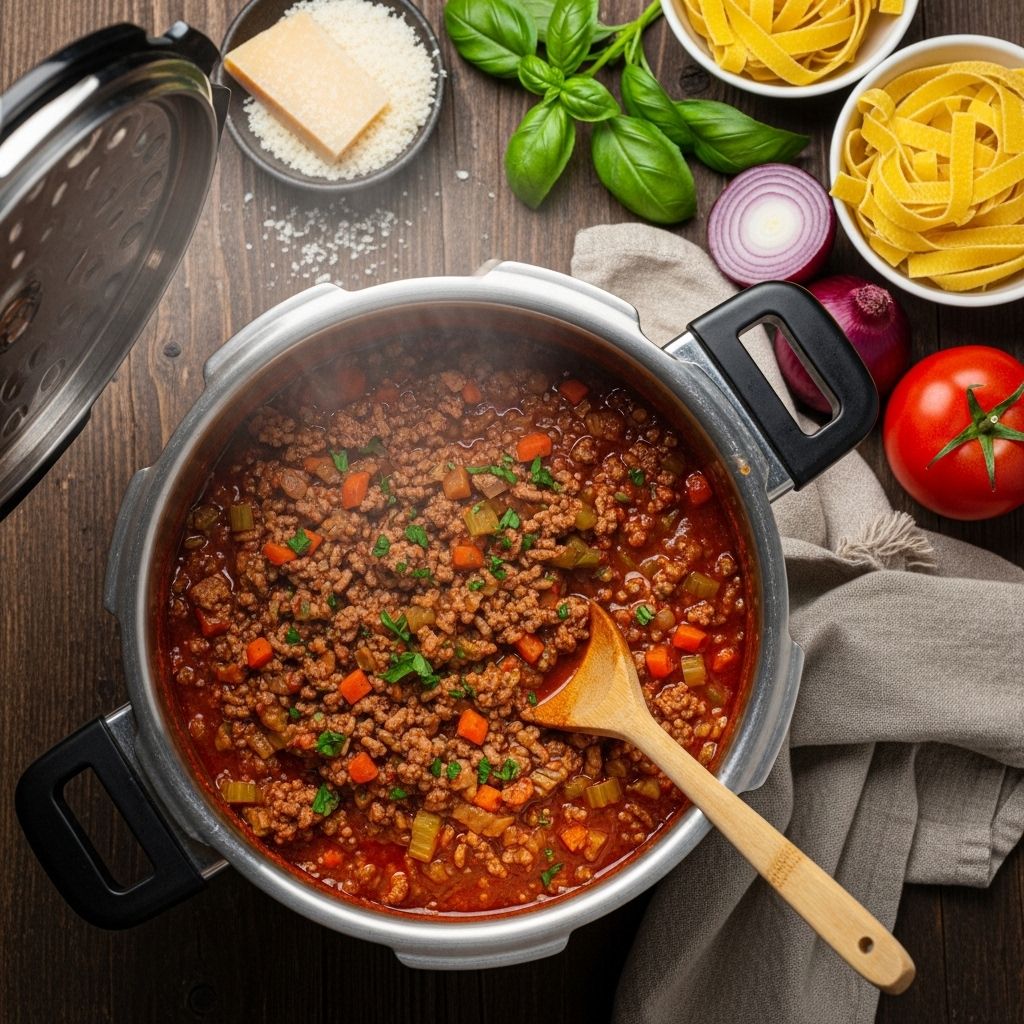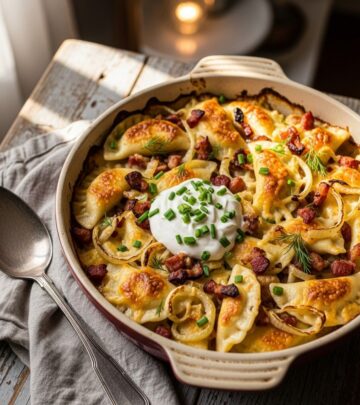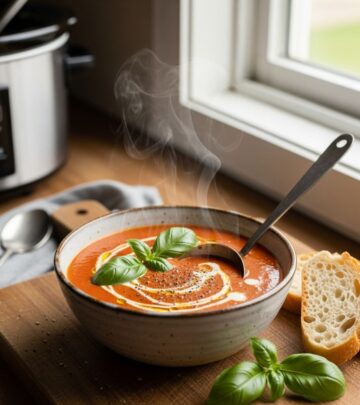Pressure Cooker Ragù Bolognese: Italy’s Classic Meat Sauce in Less Time
Unlock deep flavor and classic Italian comfort in a fraction of the time using your pressure cooker to make traditional ragù Bolognese.

Pressure Cooker Ragù Bolognese: A Classic Recipe Modernized
Ragù Bolognese is among Italy’s most beloved culinary achievements: a robust, slow-cooked meat sauce built for blanketing wide ribbons of fresh pasta or hearty dry cuts. Traditional methods demand hours of patient simmering, coaxing out deep flavors and lush texture, but modern pressure cookers like the Instant Pot can deliver the same rich results in a fraction of the time. This guide explores what makes a true Bolognese sauce, detailing how pressure cooking can streamline preparation and offering precise steps, ingredient tips, and serving recommendations to recreate the dish at home.
What Makes Bolognese Sauce Unique?
- Meat-Based: A mix of ground beef, pork, and sometimes veal or pancetta form the sauce’s base, yielding complexity.
- Soffritto: The classic aromatic blend of onion, carrot, and celery cooked slowly to build depth.
- Minimal Tomato: Unlike other Italian pasta sauces, Bolognese uses a restrained amount of tomato, prioritizing meat and aromatics.
- Milk or Cream: Adding dairy creates silkiness and mellows acidity.
- Long Cooking: Traditionally, flavors meld over low heat for three hours or more.
- Pasta Pairing: Served with fresh tagliatelle, pappardelle, or sturdy bronze-cut dry pasta; generously topped with Parmesan.
Classic Ragù Bolognese Ingredients
Authentic ragù Bolognese relies on high-quality meats, aromatic vegetables, and judicious seasoning. While pressure cooking shortens the process, ingredient selection and sequence still matter.
- Olive oil: For sautéing and flavor foundation.
- Pancetta or Salt Pork: Adds savory fat and depth (traditionally optional).
- Ground Beef & Pork: The main protein base, typically using a mix for balance.
- Onion, Carrot, Celery: Finely diced as soffritto to release sweetness and aroma.
- Garlic: Used sparingly, if at all.
- Tomato Paste: Supplies concentrated tomato flavor.
- Crushed Tomatoes: Preferably San Marzano for optimal sweetness and acidity.
- Wine: Dry white or red, for deglazing and adding complexity.
- Milk or Cream: Creates a luxurious sauce texture.
- Nutmeg: Traditional pinch for warmth, optional.
- Salt & Pepper: For seasoning throughout the process.
- Fresh Parsley/Basil: Used for finishing and freshness.
Typical Ingredient Quantities (for 6 Servings)
| Ingredient | Amount |
|---|---|
| Olive oil | 1 tablespoon |
| Pancetta | 4–6 oz, diced |
| Ground beef chuck | 1 pound |
| Ground pork | 1/2 pound |
| Yellow onion | 1–1.5 cups, diced |
| Carrots | 1/2 cup, diced |
| Celery | 1/2 cup, diced |
| Garlic | 2 cloves, minced |
| Tomato paste | 2 tablespoons |
| Crushed tomatoes (San Marzano preferred) | 28 oz can |
| Dry wine (white or red) | 1/2 cup |
| Water or stock | 1/2 cup |
| Milk or heavy cream | 1/4 cup |
| Nutmeg | Pinch (optional) |
| Italian parsley, chopped | 1/2 cup, divided |
| Kosher salt & fresh black pepper | To taste |
Pressure Cooker Method: How to Make Ragù Bolognese
Adapting a classic, slow-cooked sauce for the pressure cooker requires a few adjustments and an understanding of how rapid cooking affects flavors and consistency. Use the following step-by-step method for optimal results:
- Sauté Aromatics: Select the hottest sauté setting on your pressure cooker. Cook onions, carrots, and celery in olive oil until they’re softened and lightly browned, about 8–10 minutes. Browning boosts flavor.
- Add Meats: Stir in ground beef, pork, and diced pancetta with salt and pepper. Use a spoon to break up the meats as they brown and release juices. Continue sautéing until browned and most of the liquid evaporates.
- Layer Tomato Paste & Garlic: Stir in tomato paste and minced garlic. Cook for 1 minute until tomato paste is darkened and fragrant — this intensifies the tomato flavor.
- Deglaze with Wine: Pour dry wine into the pot, scraping up browned bits with a wooden spoon to unlock umami and build complexity. Simmer 2–3 minutes until mostly reduced.
- Add Tomatoes & Liquid: Stir crushed tomatoes, water (or stock), half the parsley, and any optional herbs into the mixture. Bring briefly to a simmer.
- Pressure Cook: Seal the lid, set the unit to HIGH pressure for 20 minutes. The rapid cooking deepens flavor and combines ingredients efficiently.
- Quick Release & Reduce: When time is up, quickly release pressure and carefully open the lid. Switch to sauté mode (low heat) and reduce the sauce uncovered for 5–10 minutes to reach your desired thickness.
- Finish with Dairy & Season: Stir in cream (or milk), remaining parsley, nutmeg if using, and adjust salt and pepper. The sauce should be glossy, emulsified, and thickened.
- Serve on Pasta: Toss sauce with freshly-cooked pasta (tagliatelle, pappardelle, rigatoni) and add a splash of pasta water to help coat. Plate and top with grated Parmigiano-Reggiano and fresh herbs.
Pressure Cooker Advantages: Saving Time Without Sacrificing Flavor
Classic ragù requires hours of low simmering, but pressure cooking dramatically shrinks the timeline by intensifying ingredient reactions under sealed heat. Here’s what happens:
- Shortened Cook Time: The entire sauce comes together in about 90 minutes, compared to three or more hours for traditional stovetop versions.
- No Loss in Flavor: Pressure cooking gets deep, concentrated beefy and aromatic notes, especially when careful browning is done upfront.
- Reduced Liquid Needed: Less evaporation means you should use less liquid than stovetop recipes to produce the proper thickness.
- Easy Cleanup: The one-pot process minimizes mess and consolidates tasks.
Techniques for the Best Pressure Cooker Ragù
- Browning is Crucial: Browning meats and aromatics create fond — the browned bits that drive flavor. Scrape diligently while deglazing.
- Tomato Moderation: Use tomato paste for depth, but keep canned tomatoes light to avoid overwhelming the sauce’s meaty essence.
- Emulsified Texture: Don’t worry if fat separates during cooking; reducing and stirring will reincorporate it into the sauce.
- Add Dairy at the End: Stirring cream or milk in at the end preserves a smooth, creamy texture and enriches flavor.
Tradition vs. Modern Convenience
The pressure cooker adaptation honors Bolognese’s roots while making it accessible for busy home cooks. While some purists insist on slow stovetop methods, many modern kitchens embrace pressure cooking for efficiency without sacrificing authenticity.
Key Differences: Stovetop vs. Pressure Cooker Bolognese
| Aspect | Stovetop | Pressure Cooker |
|---|---|---|
| Time | 3–4 hours | 1–1.5 hours |
| Liquid Needed | More (due to evaporation) | Less (sealed cooking) |
| Flavor Development | Slightly deeper, due to longer Maillard reactions | Nearly as rich, with careful browning |
| Texture | Classic & silky | Emulsified, glossy |
Tips for Success
- Use high-quality canned tomatoes (San Marzano for best results).
- Choose ground meat with some fat for full-bodied flavor and texture.
- Browning meats and vegetables before pressure cooking markedly improves final depth.
- Finish with a splash of pasta cooking water for a creamy sauce consistency.
- Garnish with minced parsley, basil, and freshly-grated Parmigiano-Reggiano.
Serving Suggestions: Bringing It All Together
Ragù Bolognese excels when paired with fresh or substantial dry pasta:
- Traditional: Tagliatelle, pappardelle, or lasagna sheets.
- Hearty Bronze-cut Pasta: Rigatoni, fusilli, or penne for texture and sauce adherence.
- Finishing Touches: Drizzle with extra-virgin olive oil, toss in chopped fresh herbs, grate Parmigiano-Reggiano on top.
For truly restaurant-level results, combine pasta and sauce in a skillet with splash of pasta water and toss vigorously over high heat before serving to bind the sauce in a creamy, luscious blanket.
Frequently Asked Questions (FAQ)
Can I use only beef or substitute meats?
Yes. While a beef-pork mix is traditional, you can use only beef, or experiment with veal, lamb, or turkey. Add pancetta, guanciale, or even bacon for additional flavor.
Is it necessary to use wine?
Wine deglazes the pan and adds complexity. If you wish to omit alcohol, substitute with a splash of beef stock, though some depth will be lost.
How do I prevent the sauce from burning in the pressure cooker?
Scrape all browned bits thoroughly when deglazing and avoid adding too little liquid before pressure cooking.
Can I freeze ragù Bolognese?
Absolutely. Cool completely, portion into containers, and freeze for up to three months. Reheat gently in a saucepan, loosening with a splash of water or stock as needed.
How do I double the recipe?
Many users double the recipe without issue in a 6-quart pressure cooker, ensuring not to exceed the maximum fill line. Consider slightly reducing liquid and stirring well for even cooking.
Conclusion: Modern Technique Meets Old-World Flavor
Pressure cooker ragù Bolognese distills centuries of Italian culinary tradition into a practical approach for today’s kitchens, producing authentic flavor and comforting results—perfect for weeknights or special gatherings. With the right ingredients, careful technique, and attention to classic details, you’ll create a pasta sauce that rivals the slow-cooked original and celebrates both convenience and heritage.
Read full bio of Sneha Tete












